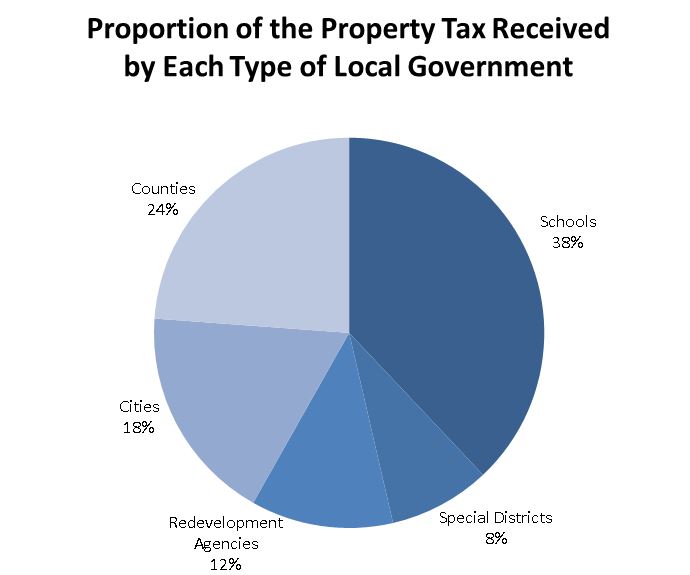This is the second blog post in our series California’s Property Tax: Where Does Your Money Go?. Today’s post describes local governments’ organization, their services, and the proportion of statewide property tax each type of local government receives.
Counties, Cities, Schools, and Special Districts Make Up California’s Local Governments. The California Constitution divides the state into counties and establishes them as subdivisions of the state. In addition to counties, state law allows local communities to form cities, schools, and special districts. For instance, local residents can establish a new city by a vote of the residents in the area. Because communities determine the jurisdictions of these local governments, the boundaries of California counties, cities, schools, and special districts overlap in varying ways across the state.
Local Governments Provide a Wide Array of Services to Their Communities. Below we describe the kinds of services each type of local government provides.
-
Counties Required To Provide Similar Services. As subdivisions of the state, the 58 counties have responsibility for significant portions of the state’s criminal justice, mental health, and social service programs. Counties also have responsibility for some countywide administrative functions—like collecting and distributing the property tax—and providing certain services to residents living outside city boundaries.
-
Cities’ Services Vary. Roughly a quarter of California’s 480 cities are “full-service” cities. Full-service cities provide almost all municipal services to their residents, including police, fire, libraries, and parks and recreation. California’s other cities, in contrast, provide a narrower range of services. In these cities, special districts (discussed below) play a larger role in providing services.
-
Schools Educate Students from Kindergarten Through Community College. School districts, county offices of education, and community colleges make up California’s education system. Statewide, there are almost 1,000 school districts, 58 county offices of education, and 72 community college districts. State law requires schools to provide certain educational programs, but schools have significant discretion in determining how to provide these programs.
-
Special Districts Provide a Variety of Services. There are over 3,000 special districts statewide. State law authorizes the services special districts can provide. Overall, there are roughly two dozen different categories of services authorized. Some of the most common services special districts provide are fire protection, water, libraries, and park and recreation.
Most Local Governments Receive Property Tax Revenue. As described in our animation, property tax revenue from the 1 percent tax forms the base for most counties’, cities’, schools’, and special districts’ budgets. Some local governments do not receive revenue from the 1 percent tax because either the local government was formed after the mid-1970s or the local government did not levy a property tax before the mid-1970s.
Former Redevelopment Agencies Also Receive Property Tax Revenue. For over 60 years, California law allowed counties and cities to redirect growth from the 1 percent tax to redevelopment agencies to address urban blight. Legislation passed in 2011 dissolved these agencies. While California no longer allows this method of redevelopment, cities and counties are still paying debts related to redevelopment agency projects. Revenue from the 1 percent tax is used to pay these debts. Once the debts are paid, that property tax revenue will be distributed to cities, counties, schools, and special districts.
Schools Receive the Greatest Proportion of Property Taxes Due to Formulas From the Mid-1970s. As seen in the figure below, schools receive almost 40 percent of statewide revenue from the 1 percent tax. While this varies across the state, in many counties, schools receive between 40 and 50 percent of the property tax revenue collected in the county. The property taxes local governments received in the mid-1970s determines the proportion of property taxes they receive today. We will discuss school funding and property taxes for other local governments further in a later post.
To receive email notices of future posts in this series, email the LAO's local government analyst, Carolyn Chu.
Follow @LAOEconTax on Twitter for regular California economy and tax updates.

